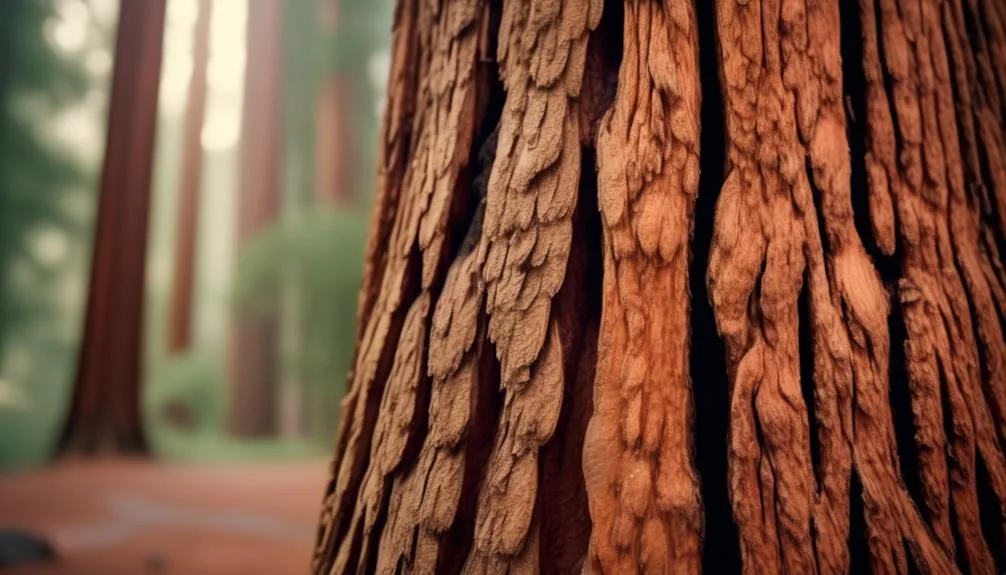Choosing a redwood tree variety is like picking a precious find. Each type, like the Coast Redwood or Dawn Redwood, has its own appeal.
To decide which one suits your space, consider factors like climate, soil, growth rate, and maintenance needs. Understanding these aspects will help you make an informed choice, ensuring your redwood thrives and becomes the highlight of your outdoor area.
Characteristics of Redwood Tree Varieties
When choosing a redwood tree variety, you'll find a diverse range of characteristics that make each type unique and captivating.
Redwood trees come in various shades of red, brown, and even purple, adding a breathtaking array of colors to your landscape.
The textures of the different varieties are equally remarkable, from the smooth, peeling bark of the coast redwood to the rough, furrowed bark of the giant sequoia.
Another crucial characteristic to consider is disease resistance. While all redwood trees are relatively resistant to pests and diseases, some varieties, like the dawn redwood, exhibit exceptional resilience.
Understanding these key characteristics will help you select the perfect redwood tree variety for your specific needs and environment.
Climate and Soil Considerations
Considering the climate and soil conditions of your location is essential when selecting the right redwood tree variety for your landscape. Redwood trees thrive in different climate zones and soil types, so understanding these factors is crucial. Redwoods generally prefer a slightly acidic to neutral soil with pH levels between 6.0 and 7.0. Additionally, they grow best in areas with cool, foggy summers and mild, wet winters, making them well-suited for coastal regions and certain inland areas. To illustrate, here's a breakdown of climate zones and soil pH levels suitable for redwood trees:
| Climate Zones | Soil pH Levels |
|---|---|
| Coastal | 6.0-6.5 |
| Inland Valleys | 6.5-7.0 |
| Mountain Regions | 6.0-6.5 |
Understanding your local climate and soil conditions will guide you in selecting the ideal redwood tree variety for your specific environment.
Growth Rate and Size
Selecting a redwood tree variety involves evaluating its growth rate and ultimate size to ensure it fits your landscape and meets your aesthetic preferences. Different redwood species have varying growth rates, with some growing faster than others. Consider the ultimate size of the tree when selecting a variety, as redwoods can range from small shrubs to towering giants.
Pruning techniques are essential to manage the growth of your redwood tree and to maintain its desired size and shape. Disease prevention is also crucial, as certain diseases can affect the growth rate and overall health of the tree.
When planting redwood trees, consider the ideal planting locations and tree spacing to accommodate their potential size and ensure proper air circulation. By understanding these factors, you can select a redwood tree variety that thrives in your specific landscape.
Maintenance and Care Requirements
To ensure your redwood tree continues to thrive in your landscape, it's essential to understand the maintenance and care requirements specific to its variety. This includes disease prevention, pruning techniques, and ideal planting locations.
Proper pruning techniques are crucial for maintaining the health and shape of your redwood tree. Regularly inspect the tree for dead or diseased branches and remove them to promote healthy growth.
Additionally, establishing a consistent watering schedule is important, especially during the tree's early years. Redwood trees generally prefer moist soil, so be mindful of dry periods and adjust your watering frequency accordingly.
Best Redwood Tree Varieties for Landscaping
When choosing the best redwood tree variety for your landscaping needs, consider the climate and space available to ensure the tree thrives in its environment.
For tree selection, the Coast Redwood (Sequoia sempervirens) is a popular choice due to its majestic height and durability. These trees can reach over 300 feet, making them a striking focal point in any landscape design.
If you have a smaller space, the Dawn Redwood (Metasequoia glyptostroboides) is a great option. It offers a graceful, pyramidal shape and stunning fall foliage.
For a unique addition, the Giant Sequoia (Sequoiadendron giganteum) is a captivating choice, showcasing a massive trunk and a commanding presence.
Consider the visual impact, space requirements, and maintenance when choosing the best redwood tree variety for your landscaping.
Conclusion
In selecting the right redwood tree variety for your landscape, it's essential to consider characteristics, climate and soil conditions, growth rate, size, and maintenance needs.
Whether it's the towering Coastal Redwood or the compact Dawn Redwood, each variety brings unique beauty and benefits to your outdoor space.
By carefully evaluating your preferences and environment, you can choose the perfect redwood tree variety to create a thriving and captivating landscape that complements your surroundings.
Mark Hoffman is a dedicated arborist and tree care specialist with over a decade of experience. His love for trees began when he visited Yosemite National Park as a teenager and was awestruck by the giant sequoias. Mark pursued his passion by studying forestry at Michigan Technological University, where he earned a Bachelor of Science degree.
Since then, he has worked tirelessly in the field of arboriculture, helping to preserve and protect trees in his community. His expertise and dedication have made him a respected leader in the industry and a valuable resource for anyone seeking advice on tree care.
